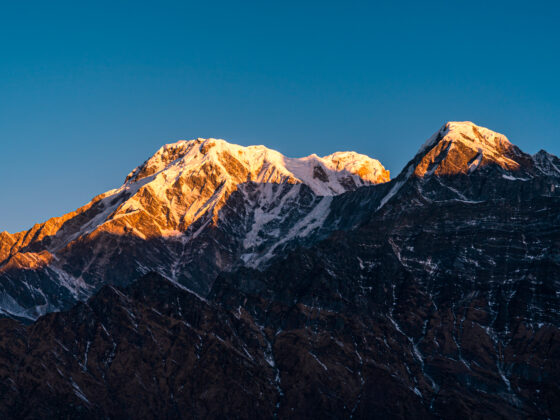Trekking in Nepal is an iconic and remarkable experience as you get the opportunity to explore the foothills of the towering peaks in the Himalayas. There are tons of exploration prospects and renowned trekking routes in Nepal. You might have heard at least one about the major trekking routes like Everest Base Camp Trek, Annapurna Circuit Trek, Langtang Trek and Manaslu Circuit Trek. These high-altitude explorations are some of the most remarkable adventures in Nepal that offer exhilarating experiences. However, these high-altitude journeys also present challenges, altitude sickness in particular is one of the major hurdles that trekkers need to prepare for.
While taking on these exciting mountain routes, it is important to be very careful about the risk of Acute Mountain Sickness (AMS). Understanding altitude sickness, its risks and preventive measures is very crucial to secure a safe and memorable trekking journey.
Understanding Altitude Sickness
The altitude sickness has several forms that determine the severity of the issue. There are a total of three such conditions; Acute Mountain Sickness (AMS), High Altitude Cerebral Edema (HACE) and High Altitude Pulmonary Edema (HAPE). Although there are risks of only AMS in this altitude base camp exploration, it will also be better if you understand the symptoms of the severe forms.
Mild Symptoms: Headache, loss of appetite, fatigue, dizziness, nausea, etc
Moderate Level Symptoms: Vomiting, persistent headaches, difficulty sleeping, shortness of breath, etc
Severe Symptoms: HAPE causes fluid to accumulate in the lungs and HACE causes the brain to swell, both of which are life-threatening conditions as a result you will start showing symptoms such as clumsiness, confusion, difficulty speaking, seizures, chest congestion, dyspnea, etc
At higher regions, the air pressure drops down significantly and the oxygen level is also lower. That’s why the body of trekkers react in different ways to altitude, especially for those who are not following a proper acclimatization schedule. For trekking adventures like Everest Base Camp Trek, Manaslu Circuit Trek and Annapurna Circuit Trek, you don’t have to make preparations for the severe forms of altitude sickness. HAPE and HACE usually occur on the alpine slopes so it is more of the climber’s obstacle. Still, you need to be watchful about the symptoms that are related to AMS in this lower elevation base camp journey.
Key Risk Factors
Rapid Ascent
One of the major risk factors that trigger the symptoms of altitude sickness is the rapid ascent. Trekkers who don’t have a good grasp on the importance of the acclimatization period try to cover a lot of distance and climb too fast to higher altitudes. If you trek this way, your body will not have enough time to adjust to the environment at higher altitudes which will cause altitude sickness. That’s why planning acclimatization days for the trek is very crucial.
A well-balanced acclimatization schedule during your exploration of the major routes like Everest Base Camp Trek, Annapurna Circuit Trek and Manaslu Circuit Trek will give your body sufficient time to adjust and adapt to varying climatic zones. Over-exhaustion is also one of the key risk factors that is related to altitude sickness. So, acclimatization will provide your body with a good rest and enough time to adjust to the atmosphere with low oxygen levels.
Physical Fitness
A physical fitness level will determine how comfortable your Himalayan journey will be. Besides that, better fitness levels have proven to make it much easier to adapt to different climatic conditions. So, if you have good fitness and stamina, you won’t have it that hard to adjust to higher altitudes. Although it does reduce the probability of altitude sickness journey, it doesn’t actually make you immune. Thus, it is also important to prioritize physical training for the trek.
Personal Susceptibility
Depending on the experience of high altitude treks and overall genetics the effects of altitude sickness can differ from person to person. Some trekkers who grew up in high-altitude regions or have prior trekking experience might not find it difficult to adjust to higher altitudes. Meanwhile, others may show symptoms even at an earlier stage due to genetics and lack of experience dealing with high-altitude climates.
Prevention Strategies
Gradual Ascent
The best way to deal with altitude sickness in any of these mountain routes whether it is Everest Base Camp Trek, Manaslu Circuit Trek, or Annapurna Circuit Trek is to follow a gradual ascent. Maintaining a gradual pace will keep your stamina level steady and you won’t exhaust yourself wither. Furthermore, your body will also have enough time to adjust to rising altitudes.
Stay Hydrated and Eat a Balanced Diet
If you stay hydrated and eat a healthy balanced diet with high nutritive value, it will keep your immune level and bodily function optimum. During the long hours of trekking journey, you will lose a lot of water level from your body and lose energy as well. So good nutrition will help you refuel and hydration will keep your body water level balanced.
Avoid Alcohol and Tobacco
For the high-altitude trekking journey, it will be best if you avoid alcohol and tobacco (cigarettes and caffeine also contribute to dehydration), which can worsen your dehydration. Overlooking these aspects may make it difficult for you to adjust to the rising altitudes.
Train Properly
Having good fitness significantly reduces the chances of you catching the symptoms of altitude sickness during the Everest Base Camp Trek. A good stamina will make your long hours of walking efficient and the cardiovascular feature will help your body to deal with low oxygen levels.
Learn to Recognize Symptoms and Take Altitude Sickness Medication if Necessary
If you understand the symptoms of altitude sickness and its severity, it will make it much easier for you to deal with it. Even if the symptoms are minor, don’t overlook them and take precautions immediately. You can also consult your doctor to take the altitude sickness medication.
Recognizing and Managing Symptoms
Identify Symptoms Early
Be vigilant about the symptoms related to altitude sickness. Don’t dismiss the symptoms like headache, dizziness, shortness of breath, etc even if they feel minor. This step is very crucial to deal with altitude sickness before it gets to a serious stage.
Take Immediate Actions
After you confirm that you are showing the symptoms of altitude sickness, you should consult with the guiding team leader immediately. Halt on the trail, get enough rest and hydrate. Your guide will then evaluate the situation to take necessary measures.
Descend if Necessary
If the symptoms of altitude sickness start to escalate, the best bet here is to make your descent to the lower elevation points on the trail. As these symptoms start to show when the body is having a hard time adapting to the elements of high altitude atmosphere, descending will minimize the scale of the symptoms.
Emergency Measures
During emergency situations, you can take portable oxygen to treat yourself. The agencies can also manage the hyperbaric chamber. But, these are not usually necessary for this base camp exploration that doesn’t take you to the alpine zone.


